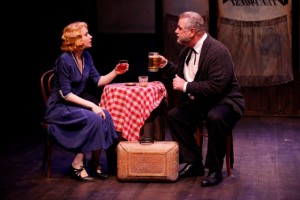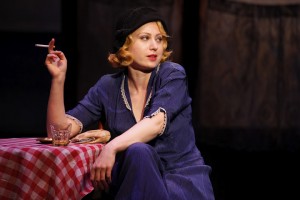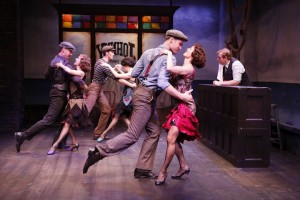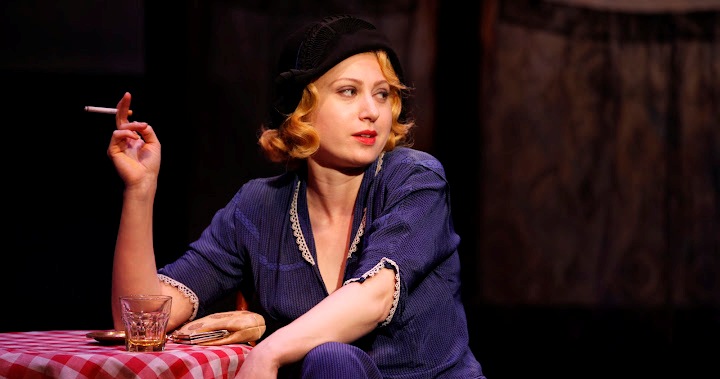
Margaret Loesser Robinson (Anna) and Cliff Bemis (Chris Christopherson) in Bob Merrill and George Abbott’s NEW GIRL IN TOWN at Irish Rep (132 W 22nd Street), directed by Charlotte Moore. (Photo credit: Carol Rosegg.)
The dramatic world of Eugene O’Neill seems an odd place to find music. We expect plenty of grief and lamentation, and enough booze to drown a mountain of sorrow, but a jaunty tune seems about as alien to O’Neill as an iPad. Nevertheless, the felicitous union of O’Neill and musical theater is precisely the task of Bob Merrill and George Abbott’s 1957 musical, NEW GIRL IN TOWN, an adaptation of O’Neill’s Pulitzer-winning ANNA CHRISTIE. On its own, the musical is a fanciful enough romance, replete with flatly drawn characters and show tunes ranging from the festive to the soulful. But taken in light of O’Neill’s play, NEW GIRL IN TOWN is a very peculiar animal indeed.
Abbott’s book preserves O’Neill’s basic plot and narrative arc. We meet Chris Christopherson drunk in a New York City wharf bar as he gets word that his daughter Anna is soon to arrive from Minnesota. An old Norwegian sailor who long ago sent Anna to live with relatives and has not seen her in fifteen years, Chris grows giddy with anticipation that his lovely daughter—a nurse!—is coming to see him, and he flees to get sobered up. Anna quickly undercuts his dotage when she arrives at the bar and delivers one of O’Neill’s most famous lines, preserved by Abbott: “Gimme a whiskey, ginger on the side—and don’t be stingy, baby.” Far from a delicate Midwestern flower, Anna is bitter and world weary, having fled Minnesota after her arrest in a raid on the brothel where she worked as a prostitute. Chris, clueless of his daughter’s nefarious past, takes her under his fatherly wing but, after warning her against the love of sailors, is thwarted and angered when Anna falls in love with an Irish seaman, Matt. The show’s tension builds around Anna’s guilt, self-loathing, and ultimately futile efforts to keep the secrets of her past while negotiating the growing animosity between the two men in her life. The requisite twists and turns of the dramatic arc notwithstanding, it never seems much of a question that love will win the day.

Margaret Loesser Robinson as Anna in Bob Merrill and George Abbott’s NEW GIRL IN TOWN at Irish Rep (132 W 22nd Street), directed by Charlotte Moore. (Photo credit: Carol Rosegg.)
Difficult though the task may seem, the wise move here is to put O’Neill as much out of mind as possible, and to take NEW GIRL IN TOWN on its own merits. As such, what we’ve got is a light-fare little musical romance with a variety of entertaining numbers and a quaint conclusion. The show’s original Broadway run was highly decorated, speaking as it did to that familiar midcentury urge for a tune and a few dance steps without much fuss. If we think too much of O’Neill’s play here, we will be tempted to find the songs clumsily tacked on, the plot awkwardly contrived, and the characters lacking their distinctive depth and grit. When Margaret Loesser Robinson’s Anna delivers her famous drink order, for example, we see not O’Neill’s grizzled and spiteful heroine, but a much more fragile, bewildered young woman, searching for, rather than cultivating, a protective outer crust. The horrors of sexual abuse at the hands of her cousins are quickly glossed over in the confessional song, “On the Farm,” and we are left with a damaged and guilt-ridden Anna who seeks out love in the context of a vulnerability entirely distinct from her O’Neillian prototype. The number “It’s Good to Be Alive” is sweet and charming coming from this Anna, while the sentiment seems entirely foreign to O’Neill’s character. One wishes that Merrill and Abbott had departed further from their source material so that the long shadow of O’Neill would not weigh this show down like so many imposing elms.
But NEW GIRL IN TOWN is not O’Neill after all, and the Irish Rep’s production does nicely find the musical’s heart. Robinson’s Anna admirably balances the guilt of her past with her aspirations for love and happiness in the future. The show’s most touching moment is Anna’s solo ballet number “If That Was Love,” a melancholy lament accompanied by a soulful score and bathed in mournful shadows by lighting designer Mary Jo Dondlinger. “If that was love, love hurts an awful lot,” sings Anna as we see her wounded interior most fully and clearly in the seediness of the wharf. The characters around her may be half-baked, but this Anna shows at least glimmers of complexity.

The ensemble in Bob Merrill and George Abbott’s NEW GIRL IN TOWN at Irish Rep (132 W 22nd Street), directed by Charlotte Moore. (Photo credit: Carol Rosegg.)
Although the songs seem often out of place in the narrative, the Irish Rep’s production, led by director Charlotte Moore, brings them to impressive life in its tiny playing space. Eleven bodies is enough to crowd this stage, but Barry McNabb’s choreography rises to that challenge with fluidity and efficiency of movement, as with the nimble tap dance of “Sunshine Girl” that opens the second act. Stephen Zinnato doing double duty throughout the show as an ensemble actor and on-stage sax player effectively accents the show’s bluesy aesthetic. Impressive also is how the design team manages to navigate the space convincingly between a barroom, a pier, and a fog-drenched barge at sea, always making the absolute most of relatively little scenery.
NEW GIRL IN TOWN’s marriage of O’Neill with musical theater is not entirely harmonious, and its sacrifices to the form—like a cast with far stronger vocal than acting chops, and a particularly baffling conclusion—are not entirely justifiable. But it remains a classic piece of midcentury musical romance, at once blemished by and admirable for the proclivities of that format.
NEW GIRL IN TOWN
Book by George Abbott
Music and Lyrics by Bob Merrill
Directed by Charlotte Moore
July 18 – September 9, 2012
The Irish Repertory Theatre
132 West 22nd Street
New York, NY, 10011
212-727-2737
http://www.irishrep.org/


